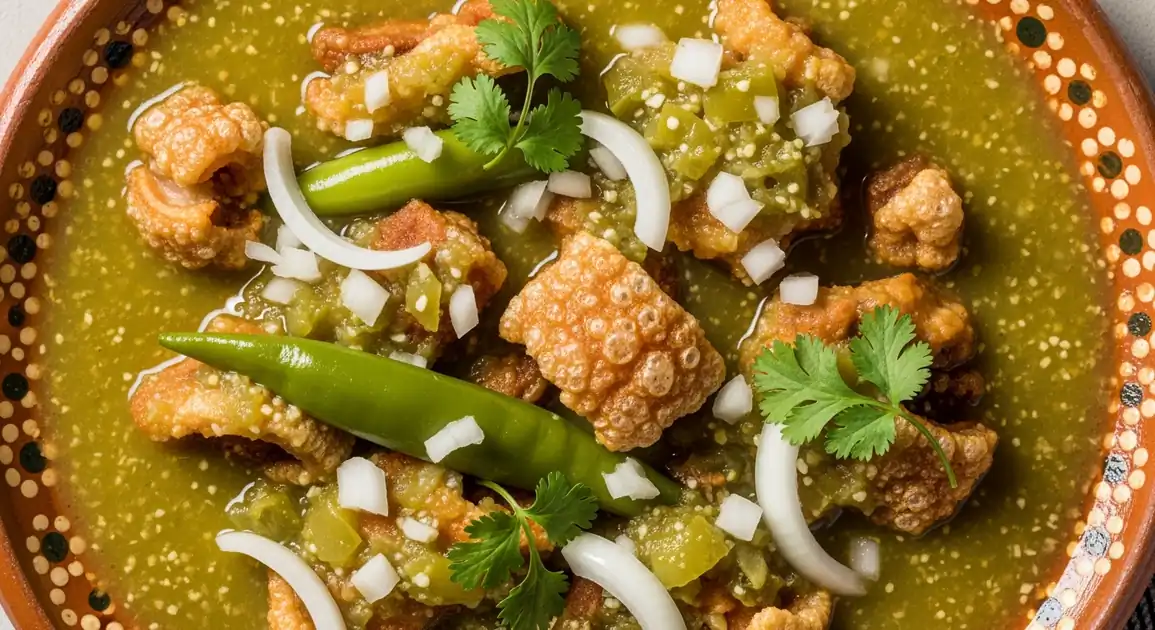Chicharrón en Salsa Verde
Chicharrón en Salsa Verde

Description
Chicharrón en Salsa Verde is enjoyed throughout Mexico, particularly in the central regions. It's a versatile dish found in contexts ranging from humble street food to home cooking to restaurant offerings. The preparation remains fairly consistent across regions, though local variations in chili heat levels and accompanying ingredients exist.
Dietary Information
Serving information
Serving style
Typically served in deep plates or bowls, accompanied by a stack of warm corn tortillas wrapped in cloth or paper to keep them warm. Often garnished with fresh cilantro, diced onion, and lime wedges on the side.
Quick facts
Most vendors serving this dish operate from early morning (around 7 AM) until mid-afternoon (around 4 PM). Some restaurants may serve it into the evening.
Safety Tips
What to Look For
-
Actively simmering sauce
The salsa verde should be visibly hot and bubbling when served, which helps ensure food safety by maintaining proper temperature.
-
Fresh, vibrant green color
A bright green sauce indicates fresh ingredients and proper preparation. Avoid brownish or dull-colored salsas that may indicate oxidation or old ingredients.
-
Clean serving containers and utensils
Proper food handling is essential - look for vendors using clean ladles, serving in clean dishes, and maintaining a generally hygienic environment.
-
Freshly heated tortillas
Quality vendors serve warm, freshly heated tortillas, indicating attention to detail and freshness throughout their operation.
What to avoid
-
Room temperature or barely warm sauce
Lukewarm sauce may harbor bacteria - the dish should be served hot enough to be steaming.
-
Sauce with separated oil or watery consistency
This may indicate the sauce has been sitting too long or wasn't properly prepared.
-
Pre-portioned servings sitting unheated
The best versions are served directly from a simmering pot rather than pre-portioned and waiting.
-
Sour or fermented smell
The dish should smell fresh and herbal - any sour or off odors could indicate spoilage.
Price information
Price range
Budget tips
- Market food stalls generally offer the best value, with full portions around 50-80 MXN.
- Street vendors often sell smaller portions as tacos for 15-25 MXN each.
- Many fondas (small family restaurants) include this dish in economical 'comida corrida' (set menu) options.
- Portions at established restaurants will cost more (80-120 MXN) but may include sides.
Value indicators
- Generous portion of chicharrón with ample sauce.
- Homemade tortillas included.
- Fresh garnishes (cilantro, onion, lime) provided.
- Complementary sides like rice, beans, or salsa cruda.
- Clearly freshly prepared rather than reheated.
Where to Find This Dish
Markets (Mercados)
Traditional public markets throughout Mexico feature food stalls serving this dish, especially in morning hours.
Regional mercados, Food court sections (comedores)
Morning, Early Afternoon
Street Food Areas
Areas known for street food vendors often include stalls specializing in guisados (stewed dishes) including chicharrón en salsa verde.
Street food corridors, Outside metro stations
Morning, Lunchtime
Residential Neighborhoods
Local fondas and small restaurants in residential areas often serve this as part of their daily menu.
Small family restaurants, Corner eateries
Lunchtime (1 PM - 4 PM)
Vendor Tips
- Look for places where locals are eating - particularly working people on their lunch breaks.
- Vendors cooking from cazuelas (traditional clay pots) often make more authentic versions.
- Ask if they make the chicharrón themselves or use commercial products - homemade is often better.
- Some places offer a sample taste (probadita) if you're unsure about spice level.
How to Order
Regional Variations
-
Chicharrón Prensado en Salsa Verde
(Chicharrón Prensado en Salsa Verde)
Uses pressed chicharrón (meat and skin compressed together) rather than regular fried pork rinds, resulting in a meatier texture and flavor.
-
Chicharrón en Salsa Verde con Nopales
(Chicharrón en Salsa Verde con Nopales)
Includes strips of cactus paddles (nopales), adding a fresh, slightly tart flavor and additional texture.
-
Chicharrón en Salsa Verde con Papas
(Chicharrón en Salsa Verde con Papas)
Includes diced potatoes, making the dish heartier and stretching the chicharrón further.
-
Chicharrón en Salsa Verde con Verdolagas
(Chicharrón en Salsa Verde con Verdolagas)
Incorporates purslane (verdolagas), a herb with slightly lemony flavor popular in traditional Mexican cooking.
-
Chicharrón Guisado
(Chicharrón Guisado)
A general term that may refer to chicharrón stewed in salsa verde or other sauces, often with additional vegetables.
Cultural context
History
This dish exemplifies Mexican resourcefulness, originating as a way to use every part of the pig. While chicharrón (fried pork skin) has been consumed since colonial times, combining it with indigenous ingredients like tomatillos and chiles to create salsa verde represents the mestizo culinary tradition. The dish became particularly popular in central Mexico, including Mexico City, where it remains a staple in markets, street stalls, and home kitchens alike.
Local significance
Represents the Mexican tradition of transforming humble ingredients into satisfying meals. Embodies the practical resourcefulness of using all parts of the animal.
Eating customs
- Typically eaten with corn tortillas, either as tacos or using the tortilla to scoop up the mixture.
- Additional salsa is often available to adjust spiciness to personal preference.
- Traditionally accompanied by beans (frijoles de olla or refried) and sometimes rice.